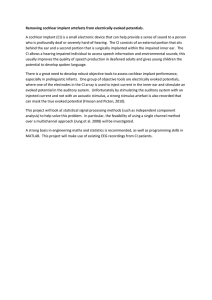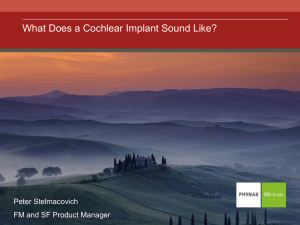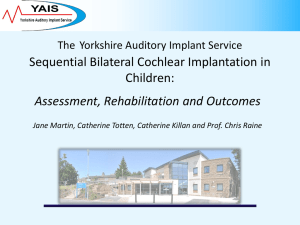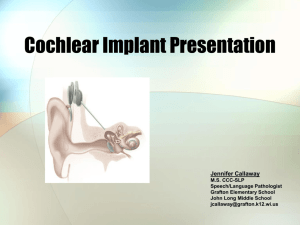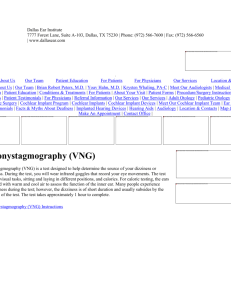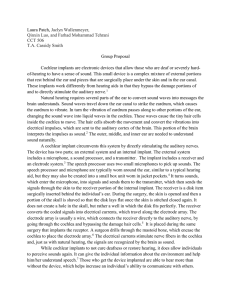Cochlear Implants - Electrical, Computer & Biomedical Engineering
advertisement
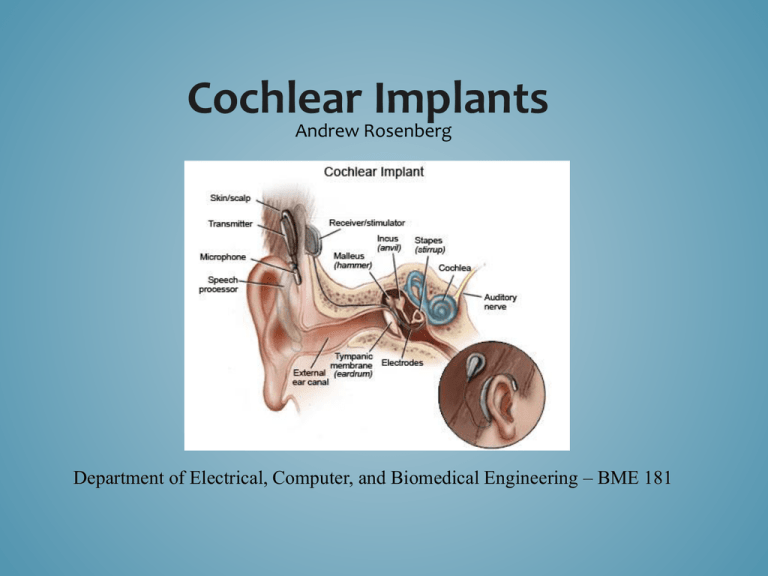
Cochlear Implants Andrew Rosenberg Department of Electrical, Computer, and Biomedical Engineering – BME 181 The Healthy Human Ear • Three Sections: (Outer ear, Middle ear, and Inner ear) • Sound waves are picked up by the outer ear and channeled to the middle ear • The middle ear relays and amplifies the sound waves headed towards the inner ear • The sound waves enter the inner ear and are translated into electrical impulses that The brain can interpret Types of Hearing Impairments 1. Conductive Hearing Loss -Usually deals with the middle ear and sound amplification -Hearing aids often help in sound amplification 2. Sensorineural Hearing Loss -Deals with damage to the hair cells throughout the cochlea -Hearing aids generally do not help sensorineural damage -Cochlear implants are an innovative way to compensate for the damaged cochlea How Does the Cochlear Implant Work? • Microphone picks up sound waves • Waves are translated into digital code by the speech processor • The receiver/stimulator sends correct amount of electrical energy to electrodes implanted in the cochlea • Electrodes directly stimulate remaining nerve fibers in cochlea • Resulting electrical information is processed by the brain Parts of the Cochlear Implant External Parts: 1. Microphone 2. Speech Processor 3. Transmitting Coil 5. Transmitter Internal Parts: 1. Receiver/Stimulator 2. Internal Coil 3. Electrodes Candidates for a Cochlear Implant Adults and Children: 1. Severe to profound hearing loss in both ears 2. Receive limited benefit from hearing aids 3. No medical problems that would complicate surgery 4. Strong willingness to participate 5. Realistic expectations (both patient and parents) Internal and External Procedure • 2-3 hour surgical procedure (under anesthesia) -small incisions made to insert receiver/stimulator and electrodes -patient usually leaves after surgery • After 4-6 weeks -patient returns for external fitting and activation -adjusting and programming can take up to several months -rehabilitation with audiologists, speech pathologists, and counselors Cost-Effectiveness • Considered one of the most cost-effective medical procedures • Average cost between $50-60,000 for surgery, programming, and rehabilitation altogether • Cochlear implants can eliminate much of the $1 million lifetime cost cost to society for a child w/o a cochlear implant • Insurance companies help more as time goes on due to the increasing societal benefit as cochlear implants improve Foreign Outlook: Cochlear implants completely covered by • U.K. government for its citizens • Medicare in Australia • Seguridad Social in Israel and Spain Future • As time goes on -implants become smaller -the magnets do not interfere with as much technology -external parts become less of a burden -batteries maintain longer life -implants are upgradable, so when new software comes out more surgery is unnecessary Older version of a cochlear implant Advanced Bionics newest implant Works Cited Information: American-Speech-Language-Hearing Association. Web. 08 Feb. 2013. <http://www.asha.org/public/hearing/Cochlear-Implant/>. "Cochlear Implants." NIDCD, n.d. Web. 08 Feb. 2013. <http://www.nidcd.nih.gov/health/hearing/pages/coch.aspx>. "Cochlear Implant." Wikipedia. Wikimedia Foundation, 27 Jan. 2013. Web. 09 Feb. 2013. <http://en.wikipedia.org/wiki/Cochlear_implant>. "How Hearing Works." HowStuffWorks. N.p., n.d. Web. 08 Feb. 2013. <http://science.howstuffworks.com/life/human-biology/hearing.htm>. What Is a Cochlear Implant? University of Miami School of Medicine, n.d. Web. 08 Feb. 2013. <http://cochlearimplants.med.miami.edu/implants/index.asp>. Pictures: Kidshealth.org/parent/general/eyes/cochlear.html> www.advancedbionics.com/us/en/products/hires_90k_implant.html www.tinnitusformula.com/library/cochlear-implants-and-electrical-stimulation/ www.european-hearing.com
